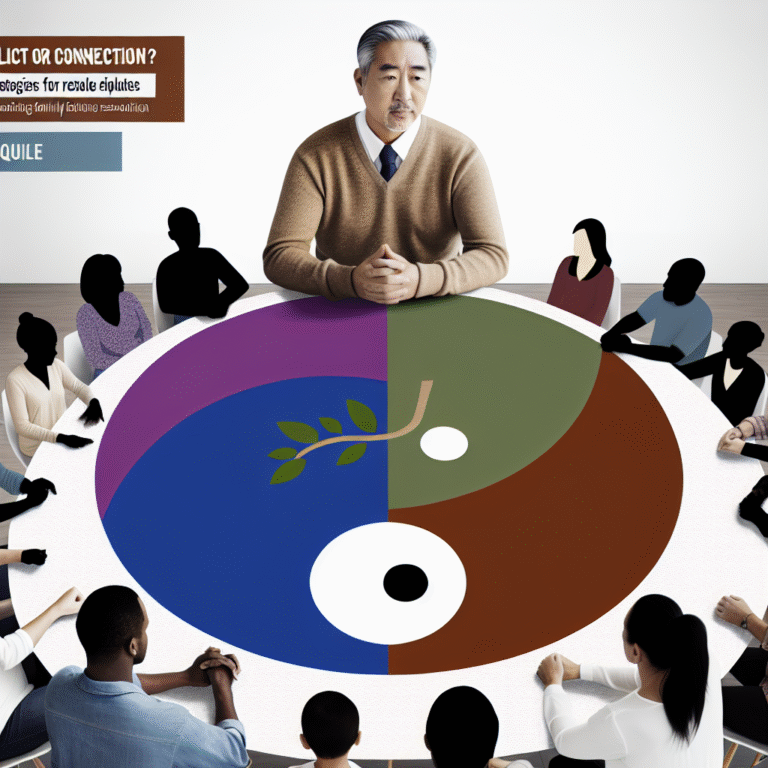
Family Feuds No More: The Essential Guide to Resolving Conflicts with Compassion
Introduction: Breaking the Cycle of Strife
Family feuds can feel like storms brewing on the horizon, bringing tension, anxiety, and sometimes, lasting damage. Whether it’s a disagreement over a financial issue, a clash of personalities, or unresolved childhood wounds, these conflicts can escalate quickly. Imagine a world where family feuds are no more—a space filled with understanding and compassion, where conflicts are navigated skillfully rather than letting resentment fester. Welcome to Family Feuds No More: A Guide to Resolving Conflicts with Compassion, where we’ll explore how to transform familial discord into harmony.
Understanding Family Feuds: The Root Causes
The Emotional Landscape of Family Conflicts
At the heart of many family feuds lies a tangled web of emotions. From jealousy and resentment to disappointment and fear, understanding these emotional triggers is the first step toward resolution. But how do these feelings manifest? Consider this table:
| Emotion | Trigger | Potential Conflict |
|---|---|---|
| Jealousy | Perceived favoritism | Sibling rivalry |
| Resentment | Unresolved past grievances | Long-standing familial tensions |
| Disappointment | Unmet expectations | Disagreements over life choices |
| Fear | Loss of family structure | Resistance to change or new ideas |
Case Study: The Smith Family
The Smith family experienced a significant fallout when the eldest sibling, David, decided to relocate for a new job. His parents felt he was abandoning them, while David believed he was pursuing his dreams. Initially, this led to a communication breakdown. However, by recognizing their emotions—David’s ambition contrasting with his parents’ fear—they found common ground. Thus begins the journey of resolving conflicts with compassion.
Communication: The Cornerstone of Resolution
Active Listening: An Underutilized Skill
Active listening is critical in transforming family feuds into constructive conversations. It involves not just hearing words, but understanding the emotions behind them. Here’s a simple breakdown of how to practice active listening:
- Focus your attention: Set aside distractions.
- Reflect on what you hear: Paraphrase or summarize their words to show understanding.
- Ask open-ended questions: This opens the floor for more dialogue.
Case Study: The López Family
In the López family, siblings Mara and Rio often argued about parental care decisions. During a family meeting facilitated by a neutral third-party, Mara practiced active listening and realized Rio was overwhelmed by responsibilities rather than apathy. Through open dialogue facilitated by compassion, the siblings were able to reassign tasks based on each person’s strengths and weaknesses.
Building Empathy: Walking in Each Other’s Shoes
Cultivating Compassionate Perspectives
Empathy plays a vital role in resolving family conflicts. It allows individuals to understand differing viewpoints, fostering compassion. Here are actionable steps to develop empathy:
- Share personal stories: This can create a sense of vulnerability and understanding.
- Encourage perspective-taking: Ask each family member to express how they believe others feel.
Case Study: The Chen Family
The Chen family faced a feud when their parents insisted on traditional education paths for their children, who yearned for creative careers. By sharing their aspirations and fears, each member developed empathy for the other’s perspective, transforming a heated disagreement into a constructive dialogue.
Setting Boundaries: A Necessary Step
Establishing Healthy Limits
While compassion is essential, it’s equally important to establish boundaries to prevent future conflicts from arising. Here’s how families can do so effectively:
- Communicate your needs clearly: Be explicit about what you are comfortable with.
- Be consistent: Once boundaries have been established, it’s vital to adhere to them.
Case Study: The Johnson Family
The Johnsons faced ongoing issues due to their adult children frequently overstepping boundaries regarding parenting styles with their grandchildren. After a family meeting where boundaries were discussed empathetically, they reached an agreement that respected each parent’s values, leading to significantly less conflict.
Conflict Resolution Strategies: Tools for Success
Effective Approaches to Conflict
When family feuds arise, having a toolbox of strategies can make all the difference. Here are some that work:
- Collaborative Problem Solving: Focus on shared interests rather than positions.
- Mediation: Involve a neutral third party to guide discussions.
- The "I" Statements Approach: Use phrases that express personal feelings without blame (e.g., "I feel upset when…").
Table: Family Conflict Resolution Strategies
| Strategy | Description | Ideal Use Case |
|---|---|---|
| Collaborative Problem Solving | Find solutions that address interests of all parties | When disagreements become personal |
| Mediation | Professional helps facilitate a calm discussion | Long-standing feuds that seem unresolvable |
| "I" Statements | Focuses on expressing feelings instead of blaming | To reduce defensiveness in conversations |
Case Study: The Garcia Family
The Garcias encountered a problem with the treatment of their elderly grandmother. By employing mediation techniques, they were able to facilitate a discussion that allowed all members, from the youngest to the oldest, to express their opinions. The final resolution included a care schedule that respected each family member’s concerns and capabilities.
The Aftermath: Maintaining Peace
Open Dialogue: Keeping Lines of Communication Open
After a conflict has been resolved, maintaining an open dialogue is crucial to prevent future feuds. Families should implement regular check-ins where everyone can express feelings and concerns.
Case Study: The West Family
With their longstanding feud now behind them, the West family decided to hold weekly family discussions. This proactive approach has not only reinforced their newfound harmony but also allowed them to address issues before they escalate, a perfect example of the “Family Feuds No More: A Guide to Resolving Conflicts with Compassion” in practice.
Conclusion: Embracing Compassion as a Way of Life
Resolving family conflicts doesn’t have to be a daunting task. By embracing compassion and understanding through the strategies discussed in this guide, families can turn acrimony into affection. The transformation from family feuds to family bonds is not just a dream; it’s an achievable reality. Remember, a compassionate approach can pave the way for lasting peace.
FAQs: Your Questions Answered
1. What can I do if one family member refuses to communicate?
Encourage open dialogue by inviting the individual to share their feelings. If they remain resistant, it might be beneficial to involve a neutral third party.
2. How can I address unresolved issues from childhood?
Begin by sharing your feelings with family members. Use "I" statements to express your feelings without placing blame.
3. Is it ever too late to reconcile?
It’s never too late for reconciliation, provided there’s a genuine willingness from all parties involved to engage compassionately.
4. How can I maintain peace after resolving a conflict?
Regular family meetings can provide a platform for open discussions and help address any brewing concerns early.
5. What if my efforts to resolve conflicts fail?
If your attempts do not yield positive results, consider involving a family therapist who can facilitate dialogue and offer additional strategies.
In the end, embracing the mantra of Family Feuds No More: A Guide to Resolving Conflicts with Compassion can turn familial feuds into heartfelt connections, enriching our lives through shared understanding and love.














